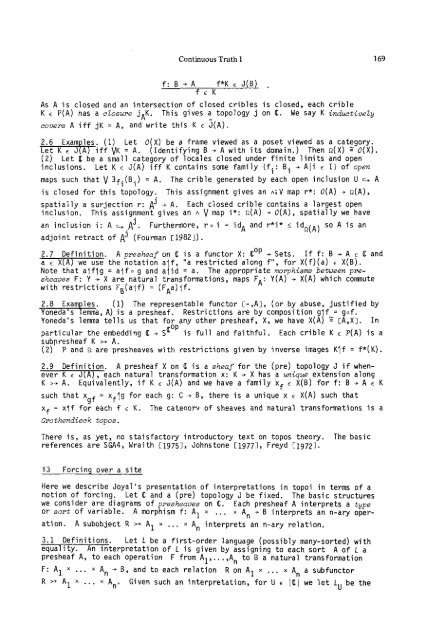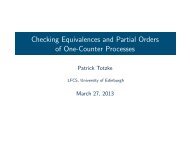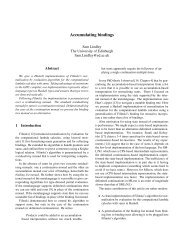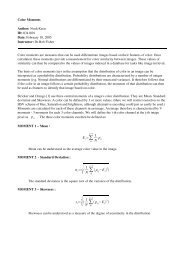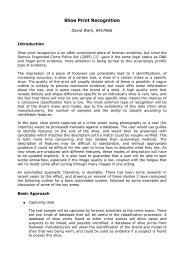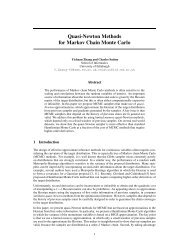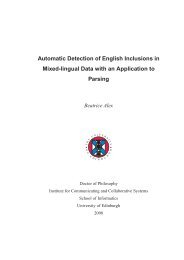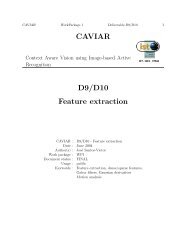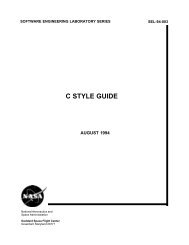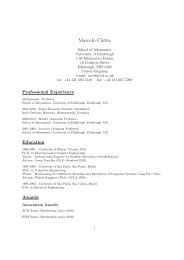Continuous Truth I Non-constructive Objects
Continuous Truth I Non-constructive Objects
Continuous Truth I Non-constructive Objects
You also want an ePaper? Increase the reach of your titles
YUMPU automatically turns print PDFs into web optimized ePapers that Google loves.
<strong>Continuous</strong> <strong>Truth</strong> I 169<br />
f: B + A f*K E J(B) .<br />
f c K<br />
As A is closed and an intersection of closed cribles is closed, each crible<br />
K E P(A) has a cZosure jAK. This gives a topology j on C. We say K inductiveZy<br />
covers A iff j K = A, and write this K E J(A).<br />
___R_<br />
2.6 Exam les. (1) Let U(X) be a frame viewed as a poset viewed as a category.<br />
Let K E J A iff VK = A. (Identifying B + A with its domain.) Then n(X) 1 O(X).<br />
(2) Let be a small category of locales closed under finite limits and open<br />
inclusions. Let K E J(A) iff K contains some family Ifi: Bi + Ali E 11 of open<br />
maps such that V 3fi(Bi) = A.<br />
is closed for this topology. This assignment gives an A;V map r*: U(A) + n(A),<br />
spatially a surjection r: AJ + A. Each closed crible contains a largest open<br />
inclusion. This assignment gives an A V map i*: n(A) + U(A), spatially we have<br />
an inclusion i: A c+JJ. Furthermore, r o i = idA and r*i* s id,(A) so A is an<br />
adjoint retract of AJ (Fourman C19821).<br />
2.7 Definition. A presheaf on C is a functor X: Cop + Sets. If f: B + A E C and<br />
a E X(A) we use the notation alf, "a restricted along f", for X(f)(a) E X(B).<br />
Note that alflg = alfo g and alid = a. The appropriate morpkisms between presheaves<br />
F: Y + X are natural transformations, maps FA: Y(A) + X(A) which commute<br />
with restrictions FB(a,lf) = (FAa)lf.<br />
2.8 Exam les. (1) The representable functor [-,A], (or by abuse, justified by<br />
Yone a s emma, A) is a presheaf. Restrictions are by composition glf = gof.<br />
Yoneda's lemma tells us that for any other presheaf, X, we have X(A) [A,X]. In<br />
-7++<br />
The crible generated by each open inclusion U 4 A<br />
particular the embedding C + Stop is full and faithful. Each crible K E P(A) is a<br />
subpresheaf K H A.<br />
(2) P and n are presheaves with restrictions given by inverse images Klf = f*(K).<br />
2.9 Definition. A presheaf X on C is a sheaf for the (pre) topology J if whenever<br />
K E J(A), each natural transformation x: K + X has a unique extension along<br />
K >+ A. Equivalent1 y, if K E J(A) and we have a family xf E X(B) for f: B -f A E K<br />
such that xgf = xflg for each g: C + 8, there is a unique x E<br />
xf = xlf for each f E K.<br />
Grothendieck topos.<br />
X(A) such that<br />
The cateaorv of sheaves and natural transformations is a<br />
There is, as yet, no staisfactory introductory text on topos theory.<br />
references are SGA4, Wraith C19751, Johnstone C19771, Freyd '19721.<br />
The basic<br />
53 Forcing over a site<br />
Here we describe Joyal's presentation of interpretations in topoi in terms of a<br />
notion of forcing. Let C and a (pre) topology J be fixed. The basic structures<br />
we consider are diagrams<br />
-<br />
of preskeaves on C. Each presheaf A interprets a type<br />
or sort of variable. A morphism f: A1 x ... x An + B interprets an n-ary operation.<br />
A subobject R A1 x ... x An interprets an n-ary relation.<br />
3.1 Definitions. Let L be a first-order language (possibly many-sorted) with<br />
equality. An interpretation of L is given by assigning to each sort A of L a<br />
presheaf A, to each operation F from A1,. . .,An to B a natural transformation<br />
F: A1 x ... x An + B, and to each relation R on A1 x ... x An a subfunctor<br />
R * A1 x .. . x An.<br />
Given such an interpretation, for U E JCCJ we let LU be the


